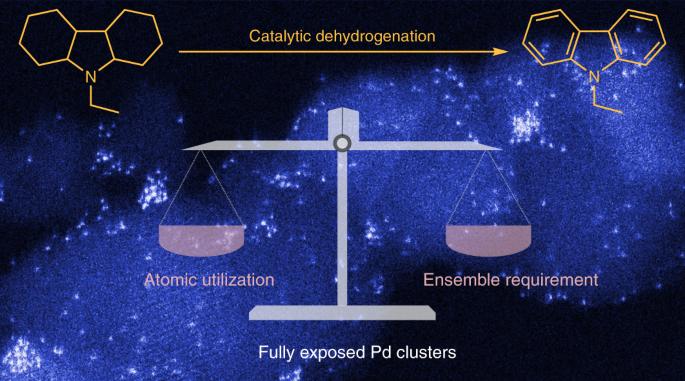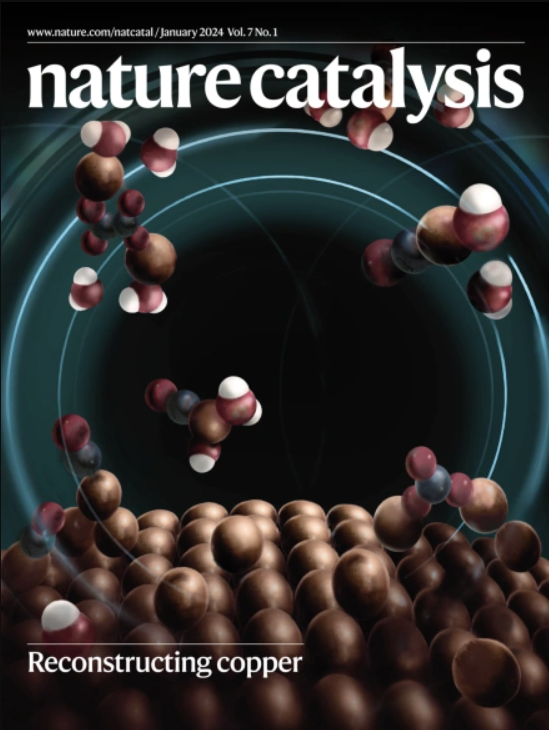完全暴露的钯簇催化剂能够从氮杂环中生产氢气
IF 42.8
1区 化学
Q1 CHEMISTRY, PHYSICAL
引用次数: 73
摘要
众所周知,支撑金属物种的大小对其催化活性有着深远的影响。然而,由于缺乏对单原子敏感且具有统计意义的量化方法,这种结构敏感性对于原子尺度的金属来说仍然模糊不清。在这里,我们克服了这一困难,对十二氢-N-乙基咔唑脱氢反应中各种表面钯物种(从单原子到亚纳米团簇和纳米颗粒)的催化贡献进行了量化,该反应对 H2 的运输和利用具有重要意义。我们的研究表明,最佳位点是一个完全暴露的钯簇,其平均钯钯配位数为 4.4,有利于反应物的活化和产物的解吸,而钯单原子几乎没有活性。我们的研究表明,在某些催化反应中,构建完全暴露的金属团簇而不存在旁观者(即本研究中的钯单原子)有助于最大限度地提高贵金属的反应活性和原子效率。结构敏感性是催化过程中的一个重要特性,但在原子团簇尺度上确定结构敏感性仍然很困难。在此,作者探索了不同低核度钯簇的反应活性,确定了十二氢-N-乙基咔唑脱氢反应的理想钯-钯配位数。本文章由计算机程序翻译,如有差异,请以英文原文为准。

Fully exposed palladium cluster catalysts enable hydrogen production from nitrogen heterocycles
The size of supported metal species is known to have a profound influence on their catalytic activity. However, this structure sensitivity remains ambiguous for metals at the atomic scale due to the lack of single-atom sensitive and statistically significant quantification methods. Here we overcome this difficulty to quantify the catalytic contribution of various surface palladium species, ranging from single atoms to sub-nanometre clusters and nanoparticles, in the dehydrogenation of dodecahydro-N-ethylcarbazole, a reaction of importance for H2 transportation and utilization. We show that the optimal site is a fully exposed palladium cluster with an average Pd–Pd coordination number of ∼4.4, favouring both the activation of reactants and desorption of products, whereas palladium single atoms are almost inactive. Our study highlights that for certain catalytic reactions, the construction of fully exposed metal clusters without the presence of spectators (that is, palladium single atoms in this work) could help to maximize the reactivity and the atomic efficiency of noble metals. Structure sensitivity is an important property in catalysis, although its determination at the atomic cluster scale remains difficult. Here, the authors explore the reactivity of different palladium clusters with low nuclearity identifying the ideal Pd–Pd coordination number for the dehydrogenation of dodecahydro-N-ethylcarbazole.
求助全文
通过发布文献求助,成功后即可免费获取论文全文。
去求助
来源期刊

Nature Catalysis
Chemical Engineering-Bioengineering
CiteScore
52.10
自引率
1.10%
发文量
140
期刊介绍:
Nature Catalysis serves as a platform for researchers across chemistry and related fields, focusing on homogeneous catalysis, heterogeneous catalysis, and biocatalysts, encompassing both fundamental and applied studies. With a particular emphasis on advancing sustainable industries and processes, the journal provides comprehensive coverage of catalysis research, appealing to scientists, engineers, and researchers in academia and industry.
Maintaining the high standards of the Nature brand, Nature Catalysis boasts a dedicated team of professional editors, rigorous peer-review processes, and swift publication times, ensuring editorial independence and quality. The journal publishes work spanning heterogeneous catalysis, homogeneous catalysis, and biocatalysis, covering areas such as catalytic synthesis, mechanisms, characterization, computational studies, nanoparticle catalysis, electrocatalysis, photocatalysis, environmental catalysis, asymmetric catalysis, and various forms of organocatalysis.
 求助内容:
求助内容: 应助结果提醒方式:
应助结果提醒方式:


